 The very moment you need help is the moment there's nobody around. 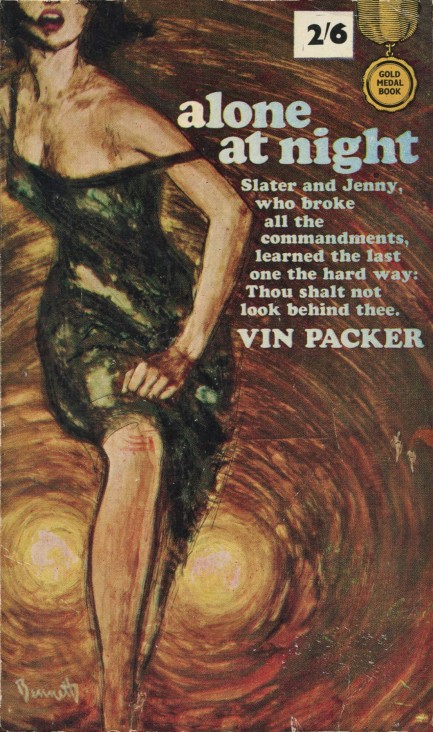
Harry Bennett put together yet another a unique paperback cover, this time for Vin Packer's 1963 novel Alone at Night. Bennett was a master illustrator who specialized in loose yet highly skilled pieces, but he had a range that we've marveled over many times. Just check his solidly representational efforts here, here, and here, as opposed to his somewhat more abstract stylings here and here, then note how he splits the difference between the two here. He's always interesting, and Alone at Night is also an interesting novel.
Vin Packer was a pseudonym for Marijane Meaker, and she sets her story in the actual small town of Cayuta, located in south central New York state. She tells us about a man named Donald Cloward who's sent to prison for fatally running over a woman. By the time he's paroled eight years later he's come to doubt the official story. On the night in question he'd been nearly incapacitated by alcohol, and had blacked out the events, yet has the vaguest memory of being placed behind the wheel of the deadly car—presumably by someone who wanted him to crash and be killed. Once dead, people would assume he stole the car.
Who would do such a thing? His father-in-law, possibly. He had offered his sedan though Cloward was clearly unable to drive. Since his father-in-law loathes him, and is not a generous man—certainly not enough to lend anyone his car—his guilt seems a good bet. On the other hand, the woman who was killed happened to be the wife of a man who desperately wanted out of his marriage in order to wed someone else. Maybe he arranged everything. After all, Cloward was found in that man's Jaguar. Yes, there may have been a switch. Cloward thinks he remembers getting into one car, even though he ended up in another. Is it a false memory?
Alone at Night is built around a leapfrogging present-past structure, and has a multi-pov narrative in which the reader soon knows all, but the characters don't. In trying to sort it all out, Cloward decides that his father-in-law moved him from the sedan to the Jaguar after realizing the second car was already pointed toward the drop-off of a cliff. After all, why merely hope for a road accident when one is already likely just by virtue of the choice of a parking space? But is he missing a few pieces of the puzzle? We won't say more about the plot. This is excellent work from Packer/Meaker. It's our second book from her, and won't be our last.
 How does an angel get its wings? Via cleverly repurposed cover art. 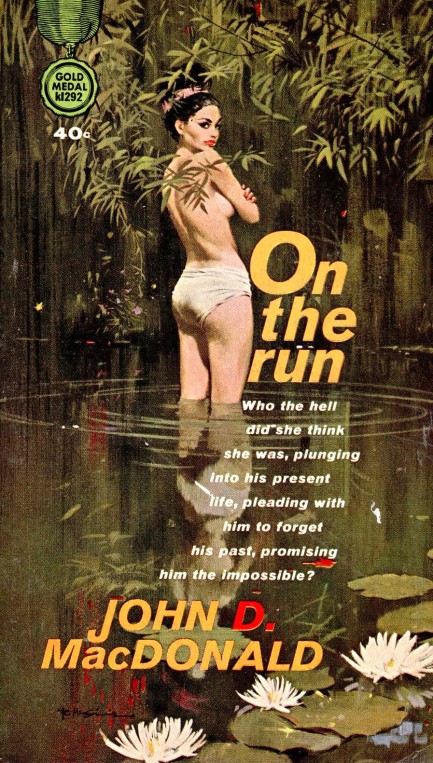 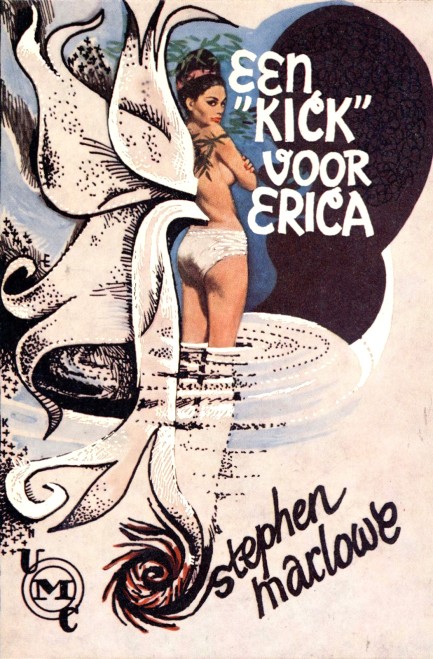
European and Australian publishers made a habit of reusing U.S. paperback art, and you see another example above. The top piece for John D. MacDonald's 1963 novel On the Run received a remix on the front of 1968's Een “kick” voor Erica, which is a translation by Dutch publishers Combinatie of Stephen Marlowe's 1967 novel Drumbeat — Erica. It's hard to improve on a McGinnis, but we think the fantasy-like transformation and giant wings—dare we say?—elevate cover number one to something even nicer. We found both on Flickr, so thanks to those two uploaders.
 In order to solve a murder sometimes it's best to proceed theologically. 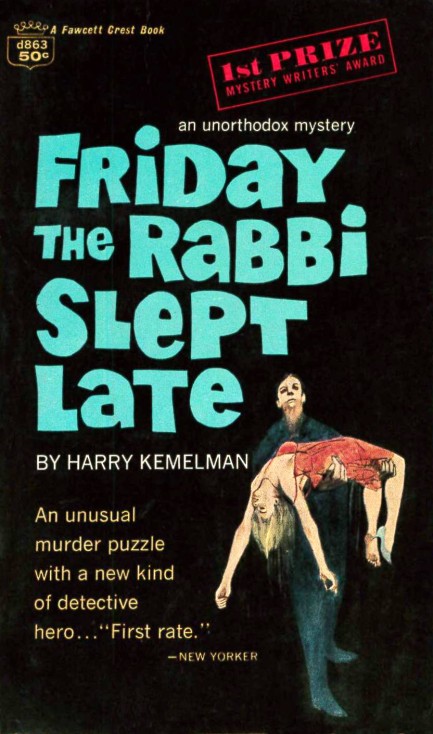
We'd never heard of the 1964 murder mystery Friday the Rabbi Slept Late, nor its author Harry Kemelman, therefore we should be forgiven for letting the title make us think the rabbi would be the victim. He wasn't. In fact, this was the first of a dozen popular mysteries starring Kemelman's franchise holy man Rabbi David Small, and we'd never heard of the books because we live part-time in a cave. What happens is a murder victim is dumped on synagogue grounds, making the rabbi a suspect, at least among the general public. The cops don't seriously consider him one, though, and the rabbi's friendship with the investigating lieutenant grows to a point where they're working together on the case. We get to see that a rabbi's duties are wide-ranging, and for those who don't know much about Judaism, there's plenty of information along those lines too. Friday the Rabbi Slept Late is a good book with a good central mystery, and it's written well, so it's no surprise that a series resulted from its unusual premise and unique hero. We'll probably try number two if we can find it. The art on this Fawcett edition is uncredited.
 Oh my God, my head is murdering me and I'm pretty sure I didn't even score last night. 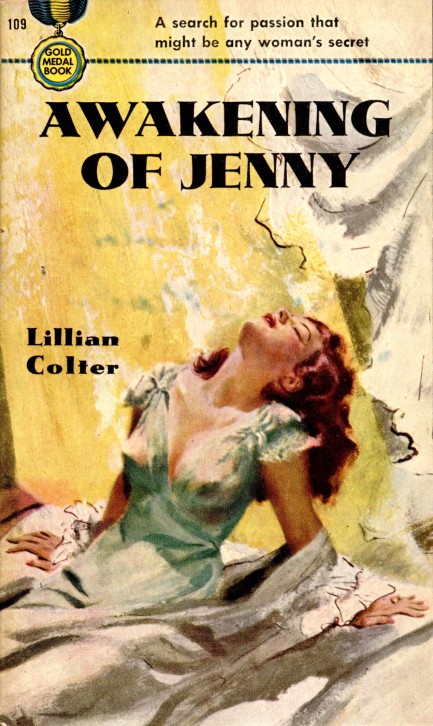
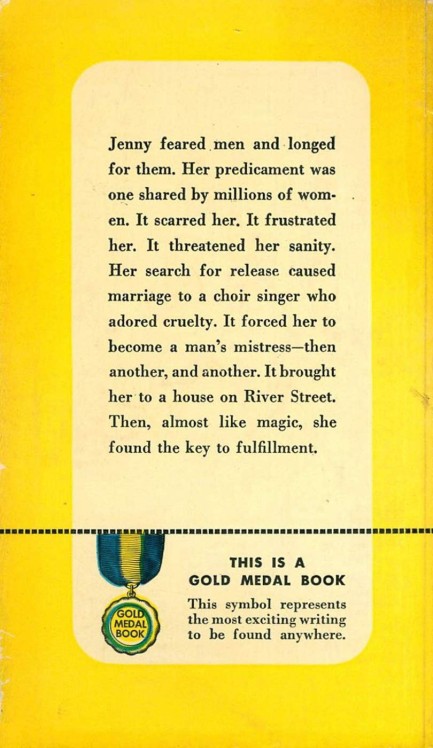 Some nights don't go as planned. But ours went fine, thanks. Hope yours was good too. The Awakening of Jenny, written by Lillian Colter and published in 1950, is pretty much as you'd guess from the title and Barye Phillips cover art. The rear cover confirms it—a woman named Jenny Adams searches for sexual and romantic fulfillment by going through a succession of men. The focus doesn't seem to be on titillation, but on psychological drama. It was a successful book, from what we gather, but Colter never wrote anything afterward, which has caused most vintage book aficionados to determine that she was a pseudonym. Some nights don't go as planned. But ours went fine, thanks. Hope yours was good too. The Awakening of Jenny, written by Lillian Colter and published in 1950, is pretty much as you'd guess from the title and Barye Phillips cover art. The rear cover confirms it—a woman named Jenny Adams searches for sexual and romantic fulfillment by going through a succession of men. The focus doesn't seem to be on titillation, but on psychological drama. It was a successful book, from what we gather, but Colter never wrote anything afterward, which has caused most vintage book aficionados to determine that she was a pseudonym.
 Hey, check it out—I can see the ironic conclusions of our character arcs from here. We better both have a drink. 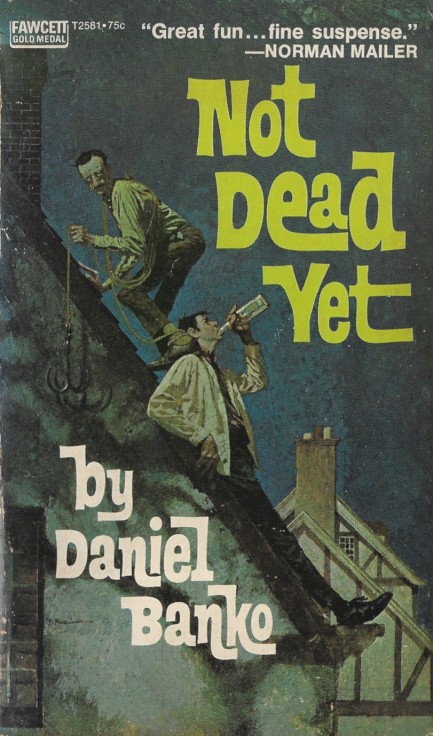
We got hold of one of the more unusual Robert McGinnis paperback covers in the form of Daniel Banko's 1972 Fawcett Gold Medal mystery Not Dead Yet. McGinnis had range, but it's still a surprise when a cover of his doesn't feature a femme fatale. This one is even more unusual due to its rooftop setting featuring a man who's wielding grappling hooks and a second who's simply drinking. Does the unusual art relate to the story? Yes, it's a moment directly from the narrative.
Banko weaves a find-the-real-killer tale in which a man named Matthew Kitterman catches his wife in bed cheating and is accused of murdering the lover. He didn't do it—he only remembers snapping a Polaroid of the tableau and bolting. He sort of flips out and next awakens in the bed of an older woman with whom he finds aid and comfort. Hunted by police and shunned by his lawyer, he finally decides he must—let's say it all together—find the real killer! In detailed and low velocity fashion he finally gets around to doing that, leading to a scene where he tries, with assistance, to break into his own house, but pauses for liquid fortification.
The book, unfortunately, did not thrill us. It reads more like a longish character piece than a crime novel. Banko can write fine, but his focus isn't particularly upon the murder nor its solution so much as portraying a man whose life has been upended and who reacts in unpredictable ways. The tale never recovered to become a gripping thriller. At least not for us. Even Norman Mailer's front cover approval didn't sway our opinion. But hey—we got the McGinnis art, and that was worth the price.
 Possession is nine-tenths of breaking the law. 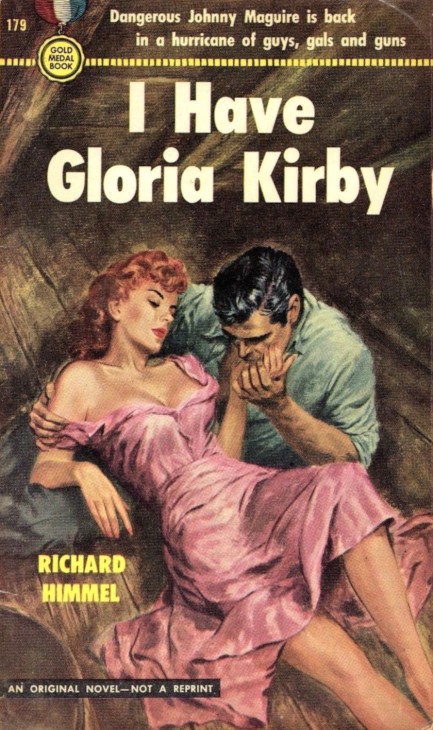
We're back to Richard Himmel today and his franchise character, Chicago tough guy lawyer Johnny Maguire. I Have Gloria Kirby came third in the Maguire series, first appearing as this Gold Medal original edition with uncredited cover art in 1951. As we mentioned before, Maguire is a lawyer, but Himmel basically treats him as a detective, and his narrative follows all the expected forms of private dick novels.
As with the earlier books, there are some good moments here. There's an excellent scene that comes after Maguire and his occasional love Tina, who works in a stenographer's office in Maguire's building, have just narrowly escaped a brutal maiming. Maguire has finished explaining to the confused and terrified Tina why everything has been happening, including why he made her burn a mink coat in the building incinerator a couple of days earlier. It's all about seventy thousand missing dollars:
“Do you know where it is, Johnny?”
“Sure. Sure, I know where it is.”
“Where?”
I dropped my gun on the desk. “You've got it.”
“What did you say?”
“I said you've got it. It's in your office. I put it there myself.”
Tina passed out. She went limp and collapsed to the floor. I let her lie there. She needed the rest. I went into my bottom drawer for the bottle. That bottle had been getting a hell of a workout. Out in the hall I rang for the elevator.
[snip]
When I went back in my office, Tina was sitting up on the floor drinking out of the bottle. “For people that burn mink coats and have seventy thousand dollars lying around, we sure drink cheap liquor,” she said.
That's pretty good. The book isn't at that level all the way through, but it's well written and keeps the tension cranked to high. The final showdown between Maguire and his organized crime nemesis is highly unlikely, but not to the extent that it ruins the tale. As mid-century detective—er, lawyer—novels go, we think I have Gloria Kirby is in the upper half of the distribution.
 With nothing more than my superhuman will I'm going to transform this primitive land into... zzzzzzzzz. 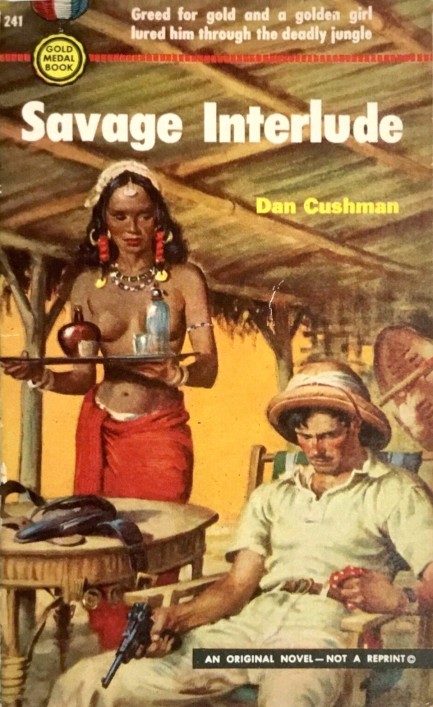
We've had two go-rounds with Dan Cushman, and he's an enjoyable author, but we decided we didn't need three engagements with him, so we didn't buy this copy of his 1952 thriller Savage Interlude. Like many others who worked this premise, Cushman's central theme was often: great men in the tropics laid low by heat, women, liquor, illness, and inscrutable natives. His work has the usual flaws of colonial centered fiction from the era, however in his favor, he knew the far flung realms of which he wrote better than most, and he was sometimes quite funny. But we've read enough to last us for a while. Want to know more about Cushman? Check here, then here.
 It's lovely out here, but the serenity and quiet just magnify everything about each other we dislike. 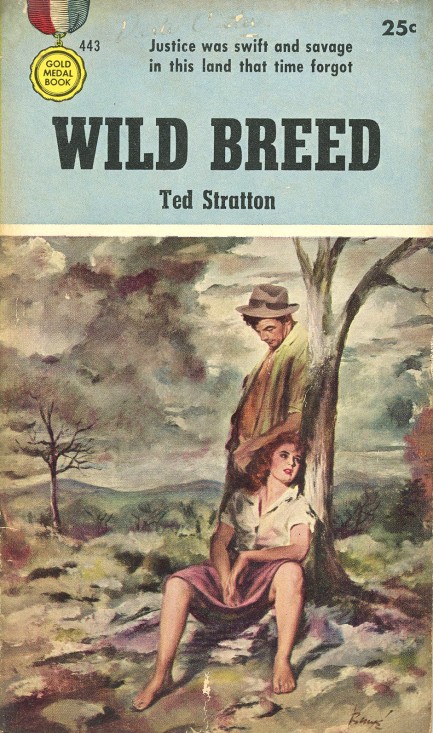 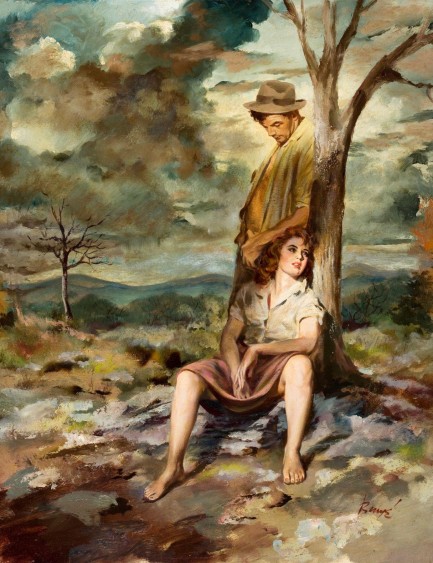
Barye Phillips handled the cover chores for Ted Stratton's 1954 novel Wild Breed, and as you can see by looking at the original reproduction we've included, the piece he produced was fine art adjacent. At least it looks that way to us. Compared to much of his other work, the detail here suggests a different frame of mind in execution, if not even a planned usage outside the realm of paperback covers for the finished piece. Its dimensions normally would have required that the work be radically cropped, but Fawcett Publications solved that by placing a solid rectangle at top to hold the text and Gold Medal logo, reducing the required trimming to a minimum. The editors knew quality when they saw it.
 Chinese communists try to whip Americans in the nuclear race. 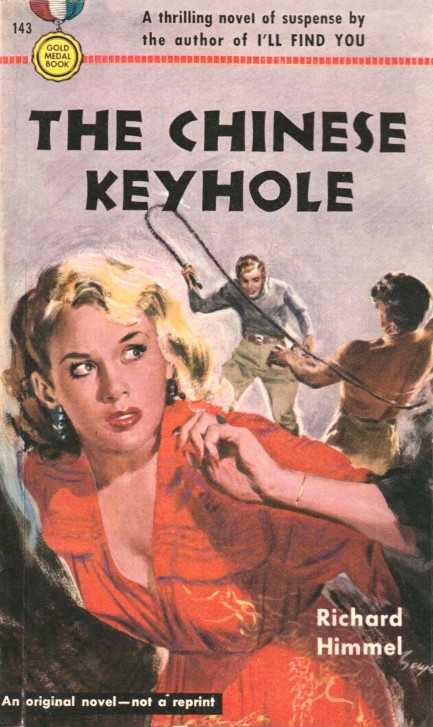
The Chinese Keyhole, Richard Himmel's second novel starring his creation Johnny Maguire, finds the ass kicking lawyer immersed in intrigue in Chicago's Chinatown district, where a mission to deliver a coded message reveals a conspiracy centered in a strip bar. Turns out communists, including a whip wielding psycho, are trying to steal nuclear secrets. Maguire is no longer just a lawyer, but a government agent with his law practice as a front. We don't remember that from the first book, but maybe we missed it.
As in the debut outing Maguire is a guy who takes what he wants, never really asking permission before laying his lips on a nearby woman, and always, of course, he's correct in his assumption that he's sexually desired. Faithful Tina from book one returns to be shabbily treated again, and as before the romantic subplots blossom into full-blown melodrama that would fit perfectly in a Harlequin novel.
We probably don't need to mention that any mid-century book with Asian characters is going to cross some lines, and Maguire doesn't defy expectations on that front, nor does he miss an opportunity to disparage homosexuality. If you haven't read many of these old thrillers you might think that was the norm, but actually it's rare because gay characters don't figure in most of the books. When they did, well, the language got baroque, to say the least. Culturally we've arrived at a better—though still imperfect—place in time.
Flaws aside, we thought The Chinese Keyhole was better written than Himmel's first Maguire novel I'll Find You. Even with this mostly hackneyed commie conspiracy potboiler, he's intrigued us enough to take another ride with his interesting lawyer/lothario/secret agent, so we'll read the third book I Have Gloria Kirby and see where that leaves us. The art on this Gold Medal edition is by Barye Phillips and it dates from 1951.
 I've almost got you! After I rescue you please don't feel any sense of gratitude that becomes confusingly sexual! 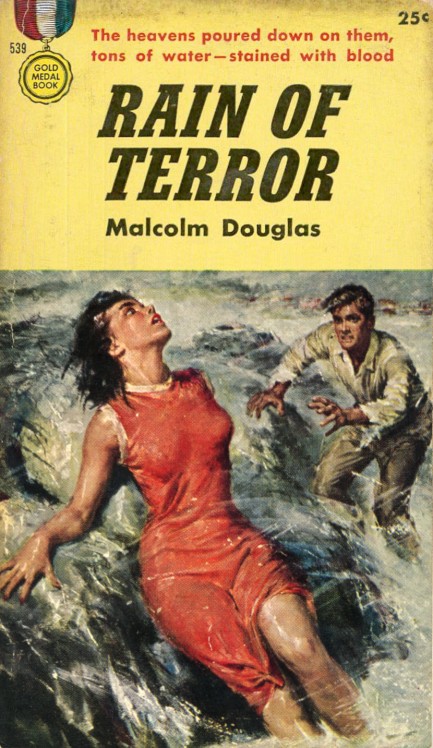
Yup, it's another disaster thriller. We told you we can't resist these. Rain of Terror was published in 1955 and came from Malcolm Douglas in a Gold Medal Edition fronted by James Meese cover art. The story takes place partly in Rome, but mainly in the fictitious Italian town of Asceno. We're always baffled when authors don't just choose a real town, but whatever. The Asceno area is being battered by a weeklong rainstorm, with flooding, looting, and chaos. Newspaperman Jake Abbott is sent to get the story. Once there, the waters nearly destroy the town, and a cache of long lost jewels appears, along with two Botticellis. The fight over these riches is predictable, but what isn't is Abbott's almost Kafkaesque nightmare as he's trapped in a town that becomes like a labyrinth. His misadventures, romantic entanglements, arrests, beatings, and wrong turns read like farce or metaphor. Rain of Terror isn't as good as other disaster thrillers we've read, but it's memorable.

|
 |

The headlines that mattered yesteryear.
2003—Hope Dies
Film legend Bob Hope dies of pneumonia two months after celebrating his 100th birthday. 1945—Churchill Given the Sack
In spite of admiring Winston Churchill as a great wartime leader, Britons elect
Clement Attlee the nation's new prime minister in a sweeping victory for the Labour Party over the Conservatives. 1952—Evita Peron Dies
Eva Duarte de Peron, aka Evita, wife of the president of the Argentine Republic, dies from cancer at age 33. Evita had brought the working classes into a position of political power never witnessed before, but was hated by the nation's powerful military class. She is lain to rest in Milan, Italy in a secret grave under a nun's name, but is eventually returned to Argentina for reburial beside her husband in 1974. 1943—Mussolini Calls It Quits
Italian dictator Benito Mussolini steps down as head of the armed forces and the government. It soon becomes clear that Il Duce did not relinquish power voluntarily, but was forced to resign after former Fascist colleagues turned against him. He is later installed by Germany as leader of the Italian Social Republic in the north of the country, but is killed by partisans in 1945.
|

|
|

It's easy. We have an uploader that makes it a snap. Use it to submit your art, text, header, and subhead. Your post can be funny, serious, or anything in between, as long as it's vintage pulp. You'll get a byline and experience the fleeting pride of free authorship. We'll edit your post for typos, but the rest is up to you. Click here to give us your best shot.

|
|









 Some nights don't go as planned. But ours went fine, thanks. Hope yours was good too. The Awakening of Jenny, written by Lillian Colter and published in 1950, is pretty much as you'd guess from the title and Barye Phillips cover art. The rear cover confirms it—a woman named Jenny Adams searches for sexual and romantic fulfillment by going through a succession of men. The focus doesn't seem to be on titillation, but on psychological drama. It was a successful book, from what we gather, but Colter never wrote anything afterward, which has caused most vintage book aficionados to determine that she was a pseudonym.
Some nights don't go as planned. But ours went fine, thanks. Hope yours was good too. The Awakening of Jenny, written by Lillian Colter and published in 1950, is pretty much as you'd guess from the title and Barye Phillips cover art. The rear cover confirms it—a woman named Jenny Adams searches for sexual and romantic fulfillment by going through a succession of men. The focus doesn't seem to be on titillation, but on psychological drama. It was a successful book, from what we gather, but Colter never wrote anything afterward, which has caused most vintage book aficionados to determine that she was a pseudonym. 

















































































